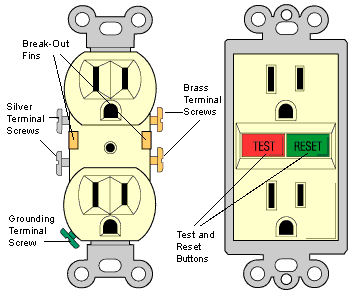What Are Three Options For Routing Electrical Services Along Clt Wall Panels?
A guide to how your home receives and distributes electric current to lights, receptacles, and appliances.
Take you ever wondered how electricity is delivered to—and routed through—your house? Understanding how a domicile'due south electrical organisation works can go a long style toward allowing you to easily and safely handle electrical problems when they arise.
The following information will walk you through how a dwelling's electrical system works.
Your Home Electric Service
Your home's electrical organisation begins with your electrical utility company, which sends electrical power to your home through electrical lines overhead from a ability pole or cloak-and-dagger through cached pipes chosen "conduit."

At the point where the power enters your house, yous'll normally find an electrical meter and primary service panel, as shown in the illustration above and photo beneath.

Here we look at the load centers—the distribution center or main console and smaller subpanels used to hook upwardly and command the various electric circuits.
Main Electrical Console
Principal panels come up in scores of sizes and configurations. A panel might be mounted on the outside of the house, either divide from or combined with the electric meter, or on an inside wall, behind the meter.
A contemporary primary panel receives 3 incoming electrical service wires and routes smaller cables and wires to subpanels and circuits throughout the house.

Ability lines connect to the two top lugs of the meter mountain. The main circuit breakers pull electricity from the two bottom lugs when the meter is in place to complete the circuit. The main breakers deliver electricity to the 2 bus bars, which in turn pass information technology along to the secondary excursion breakers.
For condom, all circuits should exist grounded: A continuous usher (often solid copper) should run from the neutral connector inside the panel to a footing such equally a water pipage or metallic rod driven directly into the ground. Unlike the hot bus bars, a neutral autobus bar does not have an over-current protection device so information technology can maintain 0 volts at all times.
Circuit Breakers and Fuses
The master console too includes some type of mechanical device for disconnecting the house's electric circuits from the incoming power. In nigh contemporary systems, this device is a circuit breaker or simply "breaker." A circuit breaker is a switch that may be shut off manually or exist tripped automatically by a failure in the electrical organisation—ordinarily an overload that could crusade the wires to rut up or even catch burn.

Other types of disconnects utilize levers and fuses—you pull downwards on a lever or pull out a fuse cake to shut off the power to the house's circuits.
The maximum amperage that a service panel may deliver at ane time is marked on the main breaker. For nigh homes, a 100-amp main is sufficient to handle all electric needs; however, many new-dwelling house builders at present install 150-amp or 200-amp services to ensure plenty of capacity. Electrical service panels rated at 60 amps or lower are undersized for contemporary needs.
Every circuit billow is rated for the blazon of wire and load required by its circuit. The well-nigh typical capacities for lighting and receptacle circuits are 20-amp and xv-amp. Standard breakers for 120-volt circuits take i slot.
Breakers for 240-volt circuits take 2 slots. Though the typical 220 breaker is twice as fatty as a standard breaker, some manufacturers make extra-thin breakers that have just half the infinite of standard breakers. Large-capacity excursion breakers are used for electric appliances such as ovens, water heaters, clothes dryers, and air conditioners, which draw a lot of ability.
Subpanels and Co-operative Circuits
Larger circuit breakers may also connect to secondary panels, called subpanels. Subpanels have their own set up of circuit breakers and power specific appliances or areas of the firm. A subpanels is oftentimes located in a different role of the house. You might, for example, detect one almost your dwelling house'due south air conditioner.

The circuits that deliver electricity to the various areas of a home are referred to as branch circuits. Branch circuits originate at a service distribution panel—either a main console or a subpanel.
For a deeper dive into electrical panels, see Electrical Service Panels and Excursion Breakers: How They Practice Their Job.
For data on wiring, see Abode Electrical Wiring.
Outdoor Circuits
Outdoor, kitchen, and bathroom electric receptacles should be protected past a special ground-mistake circuit interrupter (GFCI) circuit breaker to guard against electrocution. Because information technology is highly sensitive to any short, this type of breaker may need resetting more often than standard breakers and should exist tested periodically.

If a home electric circuit information technology supplying power to but a few outdoor receptacles, you tin can protect those receptacles by installing special GFCI receptacles. For more nearly GFCI receptacles, come across Electrical Receptacle Ownership Guide.
Featured Resources: Get a Pre-Screened Local Electrical Wiring Contractor
What Are Three Options For Routing Electrical Services Along Clt Wall Panels?,
Source: https://www.hometips.com/how-it-works/main-electrical-panel.html
Posted by: duongshateriere.blogspot.com


0 Response to "What Are Three Options For Routing Electrical Services Along Clt Wall Panels?"
Post a Comment